Introduction: Why the Spanish Diet Deserves a Spot in Your Spice Rack
The Spanish diet is more than just tapas and sangria — it’s a rich culinary tradition steeped in history, culture, and flavor. From the saffron-laced paellas of Valencia to the smoky paprika that defines chorizo, the Spanish kitchen is a treasure trove of spices waiting to be explored.
In this article, we’ll uncover how you can bring the warmth and depth of the Spanish diet into your everyday cooking with easy spice hacks, insider tips, and a few surprises along the way.
Table of Contents
- #1 – Saffron: The Golden Gem of Spain
- #2 – Smoked Paprika (Pimentón): The Heartbeat of Spanish Flavor
- #3 – Sherry Vinegar: A Tangy Game-Changer
- #4 – Herbs de la Vera: Simple Yet Mighty
- #5 – Cumin: The Secret Middle Eastern Influence
- #6 – Sea Salt: Pure & Pristine Perfection
- #7 – Chili Peppers: Spice Up Your Stew
- Buying Guide: How to Choose Authentic Spanish Spices
- Conclusion: Spice Like a Spaniard
#1 – Saffron: The Golden Gem of Spain
Saffron isn’t just any spice — it’s the crown jewel of Spanish cuisine. Harvested by hand from the crocus flower, it’s one of the most expensive spices in the world, but also one of the most transformative.

Use a pinch to elevate dishes like paella valenciana or arroz con leche. Pro tip: Soak the threads in warm water or broth before adding them to your dish to release their full aroma and color.
#2 – Smoked Paprika (Pimentón): The Heartbeat of Spanish Flavor
If there’s one spice that defines the soul of Spanish cooking, it’s pimentón. Made from smoked red peppers, this spice comes in three varieties: sweet (dulce), bittersweet (agridulce), and hot (picante).
| Type | Taste Profile | Best For |
|---|---|---|
| Pimentón Dulce | Mild, sweet, smoky | Chorizo, stews, roasted veggies |
| Pimentón Agridulce | Medium heat, complex smokiness | Pork dishes, sauces, marinades |
| Pimentón Picante | Spicy, bold, fiery | Hot chorizo, chili oil, spicy rice |
Whether you’re making patatas bravas or a rustic tomato sauce, a dash of pimentón adds that unmistakable Spanish flair.
#3 – Sherry Vinegar: A Tangy Game-Changer
Though not a spice per se, sherry vinegar is a cornerstone ingredient in Spanish cooking. Aged in oak barrels in Jerez de la Frontera, this vinegar brings brightness and depth to everything from gazpacho to vinaigrettes.

Try drizzling it over grilled vegetables or using it as a finishing touch on creamy soups. It’s an essential element in bringing balance to heavily spiced dishes.
#4 – Herbs de la Vera: Simple Yet Mighty
This aromatic blend of thyme, marjoram, oregano, rosemary, and basil is used across Spain, especially in the Extremadura region. While not as flashy as saffron or pimentón, it’s the secret behind many comforting Spanish soups, stews, and roasts.
Unlike Italian herb mixes, hierbas de la vera are typically used sparingly to enhance without overpowering.
#5 – Cumin: The Secret Middle Eastern Influence
Spain’s long Moorish history left a lasting mark on its spices, particularly cumin. Used in meat dishes, stews, and even breads, this earthy, nutty spice adds warmth and complexity.
Try adding a pinch to lentil soups, lamb tagines, or homemade chorizo blends for that authentic Spanish-Moorish twist.
#6 – Sea Salt: Pure & Pristine Perfection
Spain is home to some of the world’s finest sea salts, harvested from coastal regions like Maldon and La Flor de Sal. These coarse crystals are often sprinkled on top of dishes for texture and visual appeal.

Use it to finish off grilled meats, fresh tomatoes, or artisan bread with olive oil and pimentón.
#7 – Chili Peppers: Spice Up Your Stew
While not traditionally associated with Spanish cuisine, chili peppers have found their place in regional dishes, especially in Andalusia and Extremadura. Dried chilies like ñora and padrón add a gentle heat and vibrant color to sauces and stews.
Padrón peppers are famously unpredictable — about 1 in 10 packs a punch! Roast them quickly in olive oil and sprinkle with sea salt for a simple, addictive snack.
Buying Guide: How to Choose Authentic Spanish Spices
Finding genuine Spanish spices can be tricky, especially when browsing online or in big-box stores. Here’s a quick guide to help you pick the real deal:
Look for Region-Specific Labels
- Saffron de La Mancha: The only IGP-certified saffron in Europe.
- Pimentón de la Vera: This smoked paprika is made using traditional methods in Extremadura.
- Vinagre de Jerez: Certified sherry vinegar from the Jerez region.
Check for Quality Markers
- Deep red color in pimentón (not orange)
- Strong floral scent in saffron
- Thick, syrupy consistency in sherry vinegar
Recommended Brands
| Product | Description | Best For | Where to Buy |
|---|---|---|---|
| La Rosa Saffron | Hand-harvested from La Mancha | Paella, seafood rice, desserts | Gourmet shops, specialty food stores |
| La Dalia Pimentón | Smoked paprika from Extremadura | Meat rubs, stews, marinades | Etsy, Amazon Gourmet, Spanish import stores |
| Vinagre Los Santos | Aged sherry vinegar from Jerez | Dressings, reductions, grilled vegetables | Whole Foods, gourmet markets, online specialty shops |
Conclusion: Spice Like a Spaniard
Embracing the Spanish diet doesn’t mean you have to learn how to make paella from scratch. With just a few key spices and a bit of knowledge, you can infuse your meals with the soulful flavors of Spain.
From the golden threads of saffron to the deep smokiness of pimentón, each spice tells a story of land, tradition, and passion. Whether you're a seasoned chef or a weekend cook, these seven spice secrets will transform your kitchen — and your palate — in no time.
So next time you reach for the pepper grinder, maybe grab a pinch of pimentón instead. ¡Buen provecho!











 浙公网安备
33010002000092号
浙公网安备
33010002000092号 浙B2-20120091-4
浙B2-20120091-4